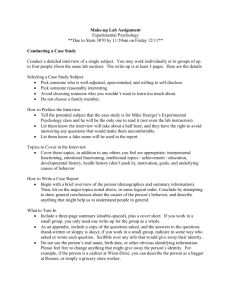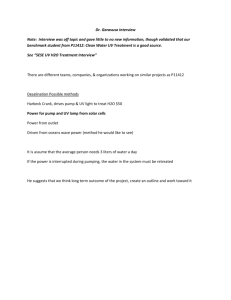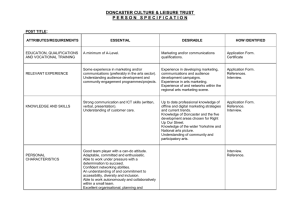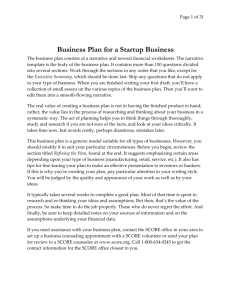Market Segmentation Worksheet
advertisement
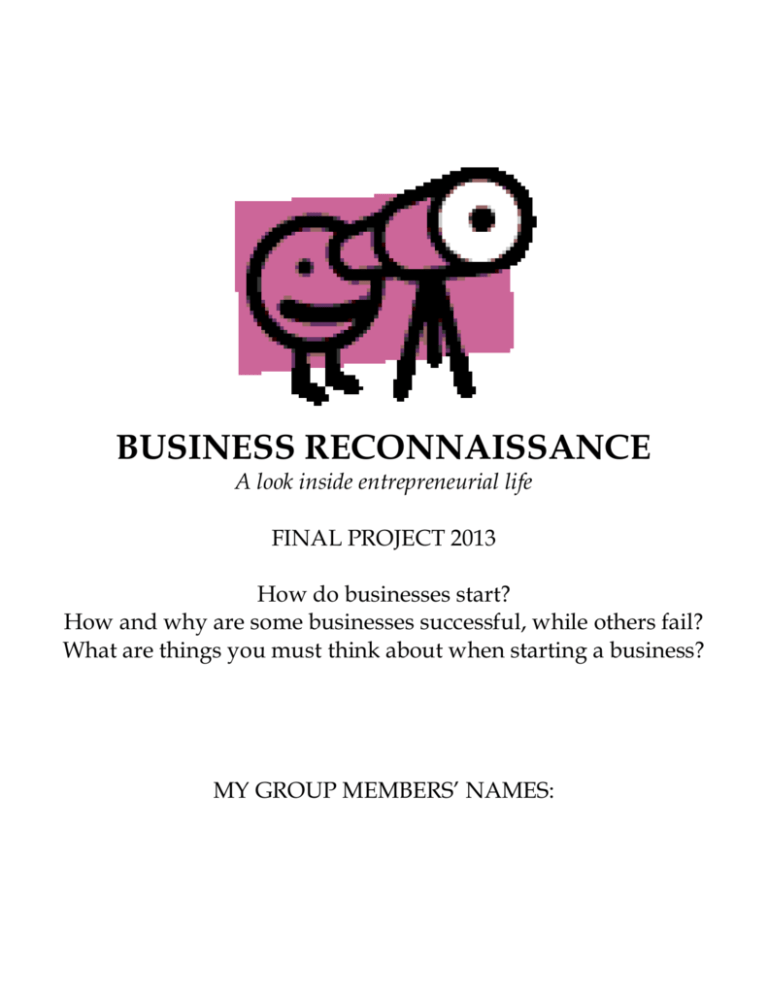
BUSINESS RECONNAISSANCE A look inside entrepreneurial life FINAL PROJECT 2013 How do businesses start? How and why are some businesses successful, while others fail? What are things you must think about when starting a business? MY GROUP MEMBERS’ NAMES: I. Learning about Markets Starting a business is not as easy as just “starting.” There are many factors that an entrepreneur has to think about before, during, and after a business is established. 1. If you were going to start your own business, what type of business would it be? Small? Large? What product(s) would you want to market? 2. How would you figure out how much it would cost to start a new business, and keep it running? Here’s a sample of categories—see if you can figure out what might be part of each. Business Costs: Administrative costs (keeps business running) Credit costs Wages and benefits for employees Sales and marketing costs Cost of sales Professional fees Technology costs Businesses, like individuals, have to make and keep a budget. If you are planning to start a business, it is critical to determine your budgetary needs. Since every business is different, and has its own specific cash needs at different stages of development, there is no universal method for estimating your startup costs. Some businesses can be started on a smaller budget, while others may require considerable investment in inventory or equipment. Additional considerations may include the cost to acquire or renovate a building or the purchase of long-term equipment. To determine how much seed money you need to start, you must estimate the costs of doing business for the first months. Some of these expenses will be one-time costs such as the fee for incorporating your business or the price of a sign for your building. Some will be ongoing costs, such as the cost of utilities, inventory, insurance, etc. While identifying these costs, decide whether they are essential or optional. A realistic startup budget should only include those things that are necessary to start a business. These essential expenses can be divided into two separate categories: fixed and variable. Fixed expenses include rent, utilities, administrative costs and insurance costs. Variable expenses include inventory, shipping and packaging costs, sales commissions, and other costs associated with the direct sale of a product or service. The most effective way to calculate your startup costs is to use a worksheet that lists both one-time and ongoing costs. II. Market Segmentation & Competition: How can you find out about competition and customers? Locations 1. What types of cereals would you find at specialty stores like Trader Joe’s, Whole Foods, and other such places? 2. Who is the target market for these specialty stores? 3. In terms of location, how do grocery stores group their cereals? Why do they do that? 4. Who would be the target market who would buy cereal in bulk at places like Costco and Walmart? Why would they buy cereal there? Income 5. What are three ways that having more money affects cereal purchases? 6. What are three ways that having less money affects cereal purchases? Quality and value 7. How can you tell if a good is a “high quality” or “low quality” product? Give specific examples. 8. How are “value” products marketed differently than “brand” products? Market Segment Analysis: McDonald’s Corporation Identify the products that would be most targeted toward each of the following market segments: Children Teenagers Adults Identify why you have chosen these particular products for each segment (characteristics, etc.) Full McDonald’s Menu is available here. III. Analyzing Business Failure: What could go wrong? How can businesses avoid this? Causality Analysis Causality is the relationship between an event (the cause) and a second event (the effect), where the second event is a result or consequence of the first event. Causes are often grouped in three types: A necessary cause X must be present to cause a result Y-- but other things may also be required to cause the result Y. If X is a necessary cause of Y, then the presence of X is required for the presence of Y. The mere presence of X by itself, however, does not guarantee that Y will occur. A sufficient cause X can cause result Y by itself. In separate instances, other causes (A, B, C) may also cause Y; but they are not needed if you have X. If X is a sufficient cause of Y, then the presence of X necessarily results in Y. A cause may be contributory if it is before the effect, and changes the effect (e.g., changing size, speed, or other attributes of the effect). In the example above, high winds might have contributed to the speed or intensity of the fire; and may have made the late arrival of firefighters a bigger problem. 1. Example Case: A house caught on fire. By the time the firefighters arrived, the house had burned down completely. The investigation determined that the initial cause was an electrical short circuit in Christmas lights. What events had to happen for the house to burn down? 2. Example Case: The pizzas at the local pizza parlor all come out burned on the bottom, and uncooked on the top. Create a fishbone analysis diagram to show what could have gone wrong. Fishbone Diagram: Used in engineering, a fishbone diagram shows the factors that cause the effect. Smaller arrows connect the subcauses to major causes. LOCAL BUSINESS INTERVIEW Group members: ___________________________________ Business interviewed: _______________________________ Person(s) interviewed: _______________________________ Role of the person(s) interview (job title(s)): ____________________________ Tips and tricks: Be sure to call a week in advance of the interview, being polite and punctual during/for the interview. You will want to interview the owner and/or manager of the business. If you can’t meet with the person face-to-face, ask if a phone or email interview would be possible. If this person is not available for an interview, pick another business. Be sure to thank the person after the interview, either by an email or a thank-you note. 1. How long have you been part of this company/business? What roles have you held since you began working here? 2. Why did you choose this company/business? (If the person is the owner, why did they choose to open this business?) 3. What sets your business apart from others in this industry/market? 4. How has the economic situation in the last few years impacted your business and others? 5. How important is keeping a budget for this business? 6. What helps you keep this business going? 7. How do you adapt your business to meet new/changing demands from your customers? 8. What is the hardest part about owning/running a business? 9. What is your favorite part about owning/running a business? 10. What advice would you give a young person looking to start a business in this industry/market? ANSWER KEYS Business Costs: Administrative costs Equipment Furniture Office supplies Licenses and permits Rent Utilities Phones Copier Credit costs Line of credit Other loans Wages and benefits Employee salaries Payroll taxes Benefits Sales and marketing costs Marketing materials Advertising Travel for client meetings Mailing lists Cost of sales Product inventory Raw materials Manufacturing equipment Packaging Shipping Warehousing Professional fees Lawyer Accountant Technology costs Computer hardware Computer software Printers Cell phones High-speed internet access




